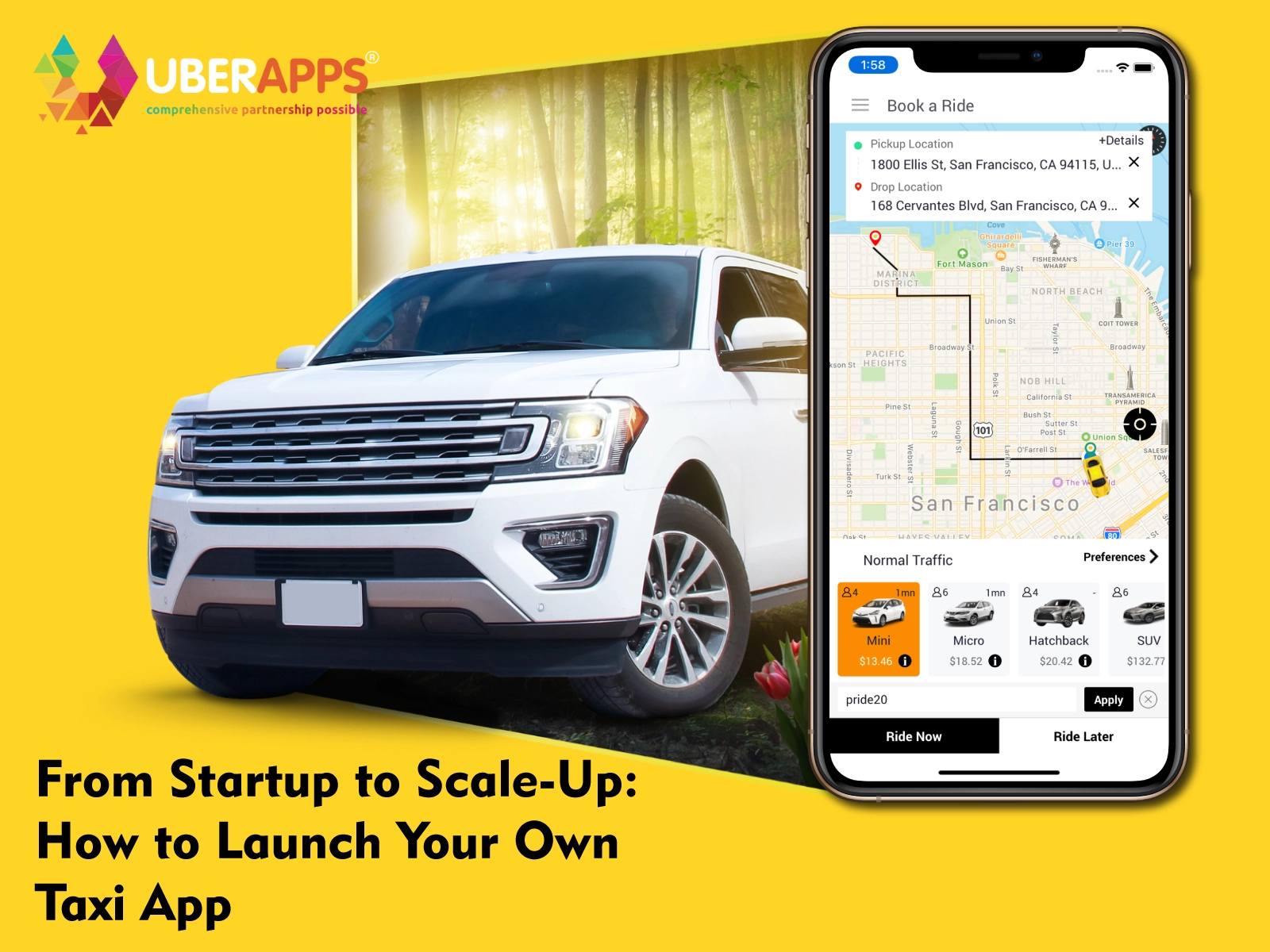
From Startup to Scale-Up: How to Launch Your Own Taxi App
Launching a taxi app is no longer just a tech trend — it’s a thriving business opportunity for entrepreneurs looking to enter the on-demand mobility industry. With the success of Uber, Bolt, and Lyft, startups worldwide are embracing Uber clone models to build reliable, feature-rich taxi booking apps that connect riders and drivers seamlessly. From in-app payments to real-time GPS tracking and driver analytics, today’s taxi app development ecosystem offers limitless scalability.
However, turning an idea into a profitable ride-hailing app requires the right strategy, technology, and execution. This comprehensive guide walks you through every stage — from concept validation and MVP launch to scaling operations — so you can confidently build and grow your own successful taxi app business.
Launching a taxi app can be the gateway from a small startup into a thriving scale-up business. In this post you’ll learn how to build a powerful Uber clone solution and position your taxi booking apps for growth. We’ll walk through market research, core ride-hailing app features, in-app payments strategy, and how to take your service from initial launch to scaling across regions. We’ll also examine monetization models, tips for user-acquisition, and technical best practices for taxi app development. Whether you’re a founder, product manager or developer, this guide gives you a roadmap to transform your concept into a full-fledged taxi business. By focusing on smart growth, robust features and the right strategy, you’ll be ready to move from startup to scale-up and make your taxi app stand out in a crowded ride-hailing market.
From Startup to Scale-Up: How to Launch Your Own Taxi App
Launching a taxi business powered by a great app is more than simply pushing a vehicle-booking button. You’re entering the competitive world of ride-hailing, where customers expect seamless service, drivers demand flexible tools and your platform needs to scale fast. In this guide on taxi app development, we’ll walk through every stage from idea and launch of an Uber clone-style solution to scaling operations, refining your taxi booking apps, implementing in-app payments for taxi apps and growing into a large-scale ride-hailing service. Let’s dive in.
Understanding the Market & Choosing Your Niche
Why the taxi-booking & ride-hailing market matters
The demand for taxi booking apps has exploded thanks to smartphone penetration, convenience expectations and on-demand culture. Researchers estimate huge growth potential in the ride-hailing space.
Identify your niche & target geography
- Urban vs suburban vs airport rides
- Local regulations & licensing
- Competitive landscape (existing taxi services & ride-hailing apps)
Validate your “Uber clone” concept
Using a white-label or clone script of the Uber model can speed your taxi app development.
Key takeaway: Focus early on a specific user-segment and region so your taxi booking apps don’t spread thin.
Planning Your Taxi App Development Strategy
Map out core features of your ride-hailing app
Before you code the driver and rider versions, you need a clear feature-list. Typical features include:
- Rider app: signup, vehicle selection, live tracking, fare estimate, book ride, payment, rating
- Driver app: registration, trip alerts, navigation, earnings report, rating
- Admin panel: driver/rider management, analytics, surge control, payments
Choose your tech stack & platform
Decide whether you’ll launch on iOS, Android or both. Consider backend infrastructure, mapping/GPS integration, push notifications, payment gateway.
Monetization & business model
Think about how you’ll make money: commission, surge pricing, subscription, dynamic pricing, driver/partner fees.
Planning for scale from the start
Even when you launch small, design architecture so you can scale to multiple cities or regions.
Key takeaway: A solid plan covering features, tech-stack and monetization makes your taxi app development journey smoother.
Designing & Developing Your Uber Clone-Style App
Wireframes, UI/UX & user flows
Map how riders book, how drivers accept, how payments get processed. Keep flows short and intuitive.
Build core modules: rider, driver, admin
Use an iterative approach: launch Minimum Viable Product (MVP) with essential features, then add advanced functions.
Implementing in-app payments for taxi apps
Payment integration is critical: card processing, wallets, in-app purchases, driver payouts. The smoother the payment flow, the better user retention.
Ensure reliability, security & compliance
- Real-time tracking (GPS)
- Secure data handling
- Driver verification & background checks
- Safety and trust (ratings, SOS, feedback) – features of modern taxi apps.
Testing, launch checklist & go-live
Before launch: branding, developer accounts (App Store/Google Play), domain & SSL, user testing, driver training.
Key takeaway: Focus on building a stable core app with payment, tracking and driver-rider flow before scaling.
Growth and Scaling: From Startup to Scale-Up
User acquisition: riders & drivers
- Launch campaigns and promotions for early users
- Driver onboarding, incentives and retention
Optimize taxi booking apps for conversion
Use App Store Optimization (ASO) and SEO for your website. Utilize correct keywords like “taxi booking apps”, “Uber clone”, “ride-hailing app features”.
Expand to new markets & geographies
Once the model works locally, replicate: localize language, payment systems, adapt to new regulations.
Performance metrics & iterating
Track key metrics: number of rides per driver, average fare, churn rate, app crash rate. Use feedback to iterate.
Leveraging partnerships & events
Collaborate with hotels, airports, events to capture ride-hailing volume.
Key takeaway: Scale happens when you combine growth tactics with operational efficiency and continuous improvement.
Advanced Ride-Hailing App Features That Set You Apart
- Dynamic pricing & surge management – Real-time adjustments in fare during high demand times keeps your business profitable.
- Multi-service expansion (ride, delivery, pooling) – Once taxi booking is stable, extend your taxi app into delivery, courier or shared rides for scale.
- In-app loyalty and rewards system – Keep riders and drivers loyal via points, discounts, driver rewards.
- Analytics & machine learning for smarter operations – Use analytics to predict demand peaks, optimize driver-rider matching, reduce idle time.
- Safety & trust features – Implement live ride tracking, SOS buttons, driver/rider feedback, verified profiles — all expected in modern apps.
Key takeaway: These advanced ride-hailing app features differentiate your platform and make scaling easier.
Monetization & Revenue Streams for Taxi Booking Apps
- Commission-based model – Take a percentage of each ride booked via your taxi app.
- Subscription or listing fees – Offer premium listing for drivers, or subscription for frequent riders.
- In-app advertisements & sponsorships – Display targeted ads or partner with brands for promotions inside your taxi app.
- Dynamic pricing & surge – During peak hours or special events increase pricing slightly and share with drivers.
- Add-on services – Airport pickups, luxury vehicles, long-distance rides or cargo options.
Key takeaway: Multiple revenue streams improve business resilience as you scale.
Technical Infrastructure & Operational Considerations
- Backend architecture & scalability – Choose scalable cloud infrastructure (e.g., AWS, Google Cloud) so your taxi app can handle growth.
- Mapping, GPS & real-time tracking – Integrate with reliable maps, optimize route calculations, provide ETA.
- Payment gateway & payouts – Secure in-app payments, driver payouts, wallet systems, support for local currencies.
- Driver support & operations dashboard – Operations team needs a dashboard to manage drivers, monitor rides, and respond to issues.
- Regulatory compliance & local licensing – Every city or country may have specific taxi-licensing, transport regulation, insurance needs. Plan accordingly.
Key takeaway: Even as a startup, designing for operational robustness avoids rework during scale-up.
Marketing Your Taxi App & Building Brand Trust
- Local SEO & service-area pages – Target keywords like “taxi booking app in [city]” or “cab service near me” to drive local organic traffic.
- Social media & influencer campaigns – Engage riders and drivers via social platforms and micro-influencers.
- Referral programmes & user incentives – Encourage users to refer friends, and drivers to refer other drivers. Early traction is vital.
- Reviews, ratings & trust-signals – Display high ratings, driver verification badges, ride-tracking screenshots to build credibility.
Key takeaway: Trust, visibility and local relevance accelerate growth of your taxi booking apps.
Measuring Success & Scaling Metrics
Key Performance Indicators (KPIs)
- Monthly active riders
- Driver utilisation (rides per driver per day)
- Average fare value
- Churn rate (riders and drivers)
- App downloads & retention
Using analytics for decisions
Use dashboards and data to decide when to expand to a new city, when to add services or raise marketing spend.
Iterative improvement & versioning
Continuously update the taxi app with bug fixes, new features and performance enhancements.
Key takeaway: Data-driven decision-making transforms your startup into a scale-up.
Conclusion
Launching your own taxi app and scaling it into a full-fledged ride-hailing platform is both exciting and challenging. From planning your Uber clone-style model to building taxi booking apps with robust ride-hailing app features and in-app payments for taxi apps, the journey demands strategic thinking, strong technology, and operational discipline. Begin by validating your niche, then execute a focused MVP with core functionality. Prioritise seamless onboarding for riders and drivers, smooth payment flows, and trust-building features.
As you grow, shift into scale-up mode: expand geographies, introduce advanced services, diversify monetisation and never stop measuring your metrics. With the right roadmap, your taxi app can evolve from a modest startup to a dynamic platform competing in the ride-hailing economy. Stay agile, iterate based on feedback and always keep the user experience at the heart of every decision. By doing so you position your taxi business for sustainable growth, strong brand presence and long-term success.
FAQS
1. What is an “Uber clone” and is it legal to build one?
An “Uber clone” is a ride-hailing app that replicates core flows like booking, matching, payments, and GPS tracking; it’s legal if you use original or licensed code, avoid trademarks/patents, and comply with local transport rules and data privacy laws.
2. How much does taxi app development cost?
Costs vary by feature set, platforms (iOS/Android), backend scale, third‑party integrations (maps, payments, SMS), team rates, and ongoing maintenance, so there’s no fixed number and budgets span widely by scope.
3. What are the must-have ride-hailing app features?
Essentials include user signup/login, live GPS tracking, fare estimation, secure payments, driver app with navigation and alerts, ratings/reviews, and an admin panel for trip, pricing, and analytics management.
4. How do I implement in-app payments for a taxi app?
Integrate gateways that support local cards, wallets, and currencies; design seamless checkout flows; automate driver payouts and refunds; and ensure encryption, PCI/GDPR/CCPA compliance, and robust reconciliation.
5. When is the right time to scale from startup to full scale-up?
Scale once you’ve achieved product‑market fit with stable operations, consistent ride growth, healthy retention, and utilization metrics that can be replicated in new markets with marginal cost.
Author's Bio

Vinay Jain is the Founder of UBERApps and brings over 10 years of entrepreneurial experience. His focus revolves around software & business development and customer satisfaction.

